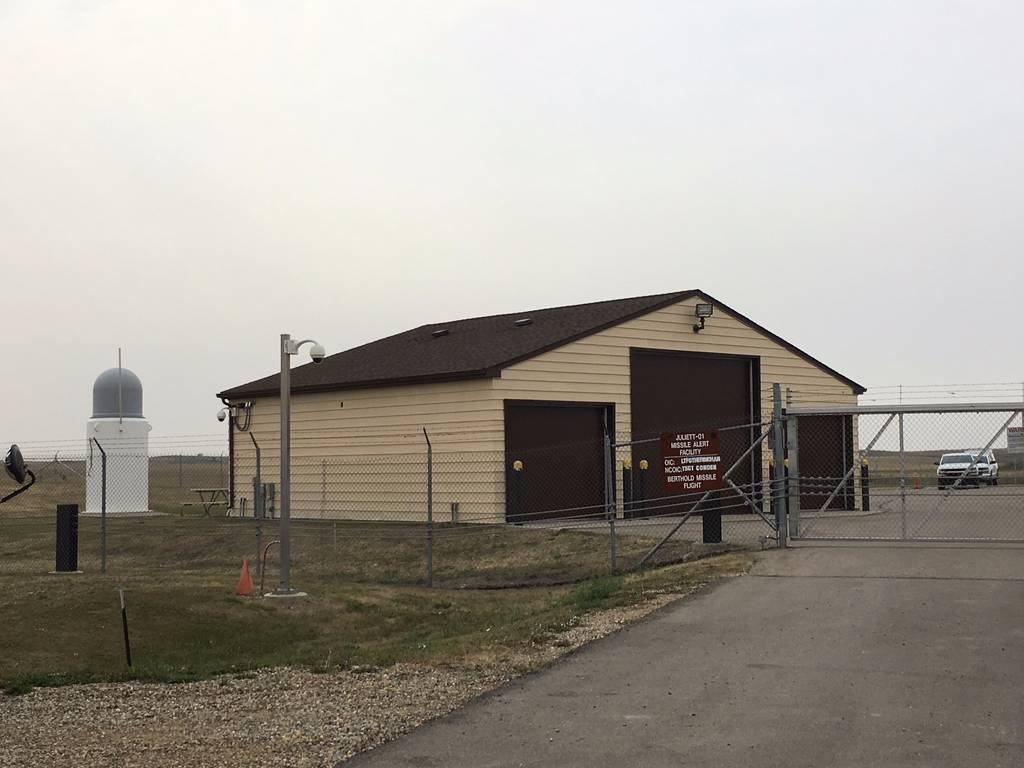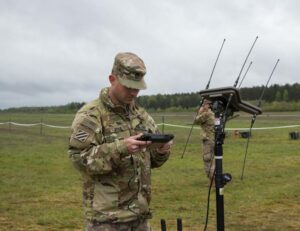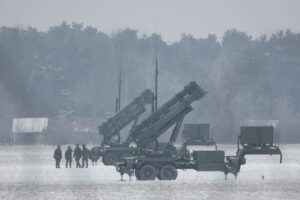
The United States should adopt a new nuclear strategy of innovation for deterrence resilience.
The newly released 2022 Nuclear Posture Review continues a Cold War strategy that prioritizes modernizing legacy nuclear weapons systems and arms control.. Reducing the risk of nuclear war requires us to update our policy and strategy to respond to changed geopolitical and technological realities.
The United States faces serious nuclear threats. Russia’s invasion of Ukraine has revived Cold War fears of nuclear war in Europe and demonstrates that nuclear powers can miscalculate. In addition, Russia is developing new long-range, nuclear-capable missile and underwater delivery systems designed to overcome missile defenses.
China is establishing a nascent nuclear triad and has added nuclear missile silos, driving calls for increased U.S. force requirements to deter both Russia and China simultaneously. U.S. Strategic Command noted our existing nuclear forces are the minimum required to achieve our national strategy, prompting the question of what additional capability is needed.
These developments and the 2026 expiration of New START — the last remaining nuclear arms control treaty providing for U.S. verification of Russian compliance with nuclear weapons limits — are paving the way to a dangerous new arms race. At the same time, attacks in the space and cyber domains could increase the risk of rapid escalation and exacerbate the dangers of misperception and miscalculation that led to several near misses during the Cold War.
The technology of nuclear war is changing. In the 1950s, the U.S. and Soviet governments raced to develop intercontinental ballistic missiles in head-to-head competition.
Today, innovation in the space, telecommunications, surveillance and data industries is increasingly driven by the commercial sector, instead of government. We must move beyond the narrow debate on types and numbers of nuclear weapons, and think bigger, bolder and more imaginatively to address new threats. The United States must start today to envision and build an innovation ecosystem that can deliver on the national security imperative of preventing nuclear war.
First, we must prioritize innovation for strategic deterrence. American commercial innovation, not additional missiles or silos, is our strategic advantage against Russia and China.
Private sector competition has drastically reduced the cost and increased access to space, thanks to development of space by companies including SpaceX and Blue Origin, small launch companies like Rocket Lab and Virgin Orbit, as well as companies like Relativity Space manufacturing 3D-printed rockets.
The private-sector revolution in Earth observation in the past decade by a myriad of new companies such as Planet and Capella Space provides us with inexpensive imagery that can be shared with the world without divulging intelligence capabilities.
This new capacity has provided increased accountability and transparency against Russia’s aggression in Ukraine. Commercial global and proliferated broadband satellites like Starlink and Project Kuiper will also connect the world and provide layers of resilience.
Second, we should focus this innovation on delivering resilient deterrence. For example, today’s reliance on a small number of billion-dollar legacy satellites risks escalation and offers to enemies what former Vice Chairman of the Joint Chiefs Staff Gen. John Hyten called “big, fat, juicy targets.”
This Cold War legacy architecture should be augmented with redundancy leveraging the thousands of commercial satellites planned for proliferated low earth orbit. The Department of Defense is exploring this model by procuring a new missile warning/missile tracking constellation consisting of more numerous, smaller satellites. A similar approach for data relay satellites will, as a corollary, also provide essential positioning, navigation and timing capabilities.
The principle of disaggregation — separating tactical from strategic communication — is also crucial to reducing the risk of miscalculation. Pivoting to this model of relying on strength in numbers rather than a few crown jewels should be pursued more broadly, particularly as new anti-satellite threats emerge.
It should also apply to other areas where the commercial sector now leads, including ubiquitous sensing, terrestrial communications networks, advanced manufacturing, and big data and social network analysis. Greater resilience will increase decision time for the president and senior military and political leaders and reduce the risk of rapid escalation across domains.
As importantly, innovation for resilient deterrence will strengthen American alliances. As emerging technologies become more salient, allies’ powerhouses of advanced manufacturing, machine learning, electronics, space, robotics and other key industries will be more important in our shared global deterrence architecture. And as commercial capabilities grow in strategic importance, the strength of allied economies will contribute more to strategic stability.
The United States should adopt a nuclear posture to lead the world in preventing nuclear war. Innovation for deterrence resilience addresses this requirement by recognizing technological change, denying adversaries any advantage from limited nuclear weapons use and including allies in building a secure global future.
Failing to incorporate new solutions and ideas for modernizing deterrence will result in replicating outdated 20th century deterrence, risks leaving the United States dangerously unprepared and squandering unparalleled American advantage in technological and commercial innovation.
Leonor Tomero served as deputy assistant secretary of defense for nuclear and missile defense policy. Prior to this role, she served for over a decade as counsel and strategic forces subcommittee staff lead on the House Armed Services Committee.
- SEO Powered Content & PR Distribution. Get Amplified Today.
- Platoblockchain. Web3 Metaverse Intelligence. Knowledge Amplified. Access Here.
- Source: https://www.defensenews.com/opinion/commentary/2023/02/14/how-to-innovate-americas-nuclear-strategy/
- 70
- a
- access
- accountability
- Achieve
- across
- addition
- Additional
- address
- addresses
- adopt
- advanced
- ADvantage
- against
- American
- analysis
- and
- Apply
- approach
- architecture
- areas
- armed
- Assistant
- Attacks
- augmented
- become
- Beyond
- Big
- Big Data
- bigger
- Blue
- blue origin
- bring
- broadband
- broadly
- build
- Building
- called
- Calls
- capabilities
- Capacity
- Century
- chairman
- change
- changing
- China
- commercial
- committee
- Communication
- Communications
- Companies
- competition
- compliance
- Congress
- Connect
- Consisting
- continues
- contribute
- control
- Cost
- could
- counsel
- Crown
- crucial
- cyber
- Dangerous
- dangers
- data
- debate
- decade
- decision
- Defense
- deliver
- delivering
- delivery
- demonstrates
- Department
- department of defense
- deputy
- designed
- develop
- Development
- developments
- domains
- drastically
- driven
- driving
- during
- earth
- economies
- ecosystem
- Electronics
- emerging
- enemies
- escalation
- essential
- Europe
- example
- existing
- Exploring
- faces
- Fat
- fears
- few
- Focus
- Force
- Forces
- Former
- from
- future
- Gen
- geopolitical
- Global
- Government
- Governments
- greater
- Grow
- House
- How
- How To
- HTTPS
- ideas
- images
- imperative
- importance
- important
- in
- Including
- incorporate
- Increase
- increased
- increasingly
- industries
- inexpensive
- Innovation
- instead
- Intelligence
- InterContinental
- invasion
- John
- joint
- Key
- lab
- Last
- launch
- layers
- lead
- leaders
- Leads
- learning
- leaving
- Led
- Legacy
- leveraging
- Limited
- limits
- Low
- machine
- machine learning
- manufacturing
- Military
- minimum
- misses
- missiles
- model
- more
- move
- nascent
- National
- national security
- Navigation
- Near
- needed
- network
- networks
- New
- new solutions
- noted
- nuclear
- Nuclear weapons
- number
- numbers
- numerous
- Offers
- Orbit
- Origin
- Other
- Overcome
- particularly
- past
- Paving
- planet
- planned
- plato
- Plato Data Intelligence
- PlatoData
- policy
- political
- positioning
- powerhouses
- powers
- president
- preventing
- principle
- Prior
- Prioritize
- project
- provide
- provided
- provides
- providing
- question
- Race
- rapid
- realities
- reduce
- Reduced
- reducing
- Relay
- released
- reliance
- remaining
- requirement
- Requirements
- requires
- resilience
- resilient
- Respond
- result
- Revolution
- Risk
- risks
- robotics
- rocket
- Role
- Russia
- russian
- same
- satellites
- sector
- secure
- security
- senior
- separating
- serious
- Services
- several
- shared
- should
- similar
- simultaneously
- small
- smaller
- Social
- social network
- Solutions
- Space
- SpaceX
- Stability
- Staff
- starlink
- start
- States
- Strategic
- Strategy
- strength
- Strengthen
- subcommittee
- such
- surveillance
- Systems
- tactical
- targets
- technological
- Technologies
- Technology
- telecommunications
- terrestrial
- The
- the joint
- the world
- thousands
- threats
- time
- timing
- to
- today
- today’s
- Tracking
- Transparency
- types
- u.s.
- ubiquitous
- Ukraine
- underwater
- United
- United States
- unparalleled
- Update
- us
- use
- Verification
- Vice Chairman
- Virgin
- war
- Weapons
- What
- will
- without
- world
- zephyrnet












